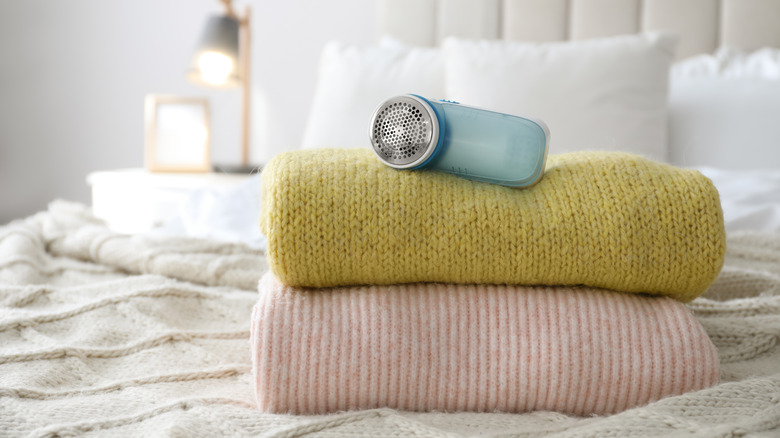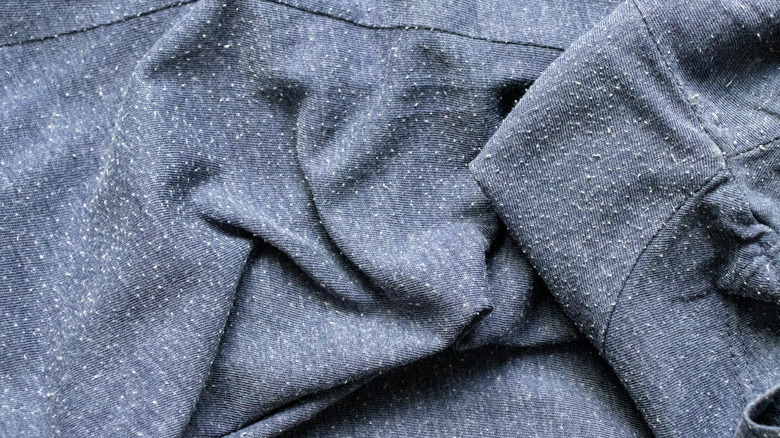What Is Clothes Pilling (And How You Can Keep It From Ruining Your Threads)?
Your closet is likely full of clothes, old and new, that you adore. Clothes can either be a statement of fashion or comfort. With that said, you probably want your clothes to last for years, especially if you paid a high price. The mistake you're making with your new clothes is not caring for them properly. Experts say there are steps to take to ensure your clothing looks new long after the tags come off. This includes washing and storing them properly. But unfortunately, garments of all kinds are susceptible to clothes pilling.
Pilling is also referred to as bobbles or bobbling. Even if you're unfamiliar with these terms, you have probably seen the effects on your clothing. Pilling can be best described as pieces of fuzz on clothing. They commonly appear on sweaters and pants, often near the underarms and the thighs. Laundry expert Patric Richardson told Today, "The issue with pilling is that the thing that makes you love a fabric is also the thing that makes it pill." Here's how to shop for garments that won't pill and how to ensure this won't happen to your clothing.
These are the causes of clothes pilling
Cashmere and knitted fabrics will pill more than others, and the same can be said for wool, cotton, and fleece. This is based on the fabric's structure — these fabrics have short fibers, which are not as long-lasting as fabric with long fibers. Synthetic fabrics like polyester and acrylic are also more prone to pilling; when something is made with one or more synthetic materials, you can expect the fabric to break down, which leads to pilling. This can be caused by wearing an article of clothing often, or it can be a result of friction caused by layering clothing. When you throw it in the wash, you'll sometimes find other fabric colors on your clothing.
This is likely from another piece with pilling in your washer. This isn't great for your clothing, aesthetically speaking or otherwise. Experts recommend that you invest in fabrics that won't pill. This includes denim, silk, and woven fabrics. Textile expert Sean Cormier told Today that tight fibers are also a must when it comes to clothing that won't pill. He explained, "The higher the twist, the firmer the feel of fabric." Cormier added, "You'll see pilling on a lot of loose knits because there's more area for the abrasion to take place and it's not as tightly twisted."
On your next shopping trip, read the label and see if the piece is synthetic or if it's made with durable fabric to determine if pilling will be an issue.
You can prevent clothes pilling
Even if your clothing is pilling, this does not mean it is completely ruined. You can easily remove the pilling with items you already have at home or purchase affordable tools. Using a razor (like the one you shave your legs with), you can easily (but carefully) shave away the pilling. Another option is rolling away the pilling with a lint roller or using a pumice stone. A fabric shaver can also get the job done. In a video, TikTok user @romymorris.x shows how a small fabric shaver gets rid of the pilling on her sweatpants in seconds.
To avoid having to use these methods in the first place, experts have tips to prevent your clothes from pilling. Read labels to learn how to wash and care for your clothing. When you throw your clothes in the washer, ensure they are turned inside out to prevent friction. Likewise, you should always wash clothing made with similar fabrics together. Instead of placing your clothes in the dryer, hang them to air dry. Experts note that tumble drying especially causes friction and, thus, clothes pilling.
The type of laundry detergent you use is also crucial. Certain laundry detergents can make your clothes fade fast, but if you use a laundry detergent with enzymes, there's less of a chance your clothing will pill. Last but not least, use a gentle cycle to prevent pilling, and wash your clothing in cold water instead of hot.


